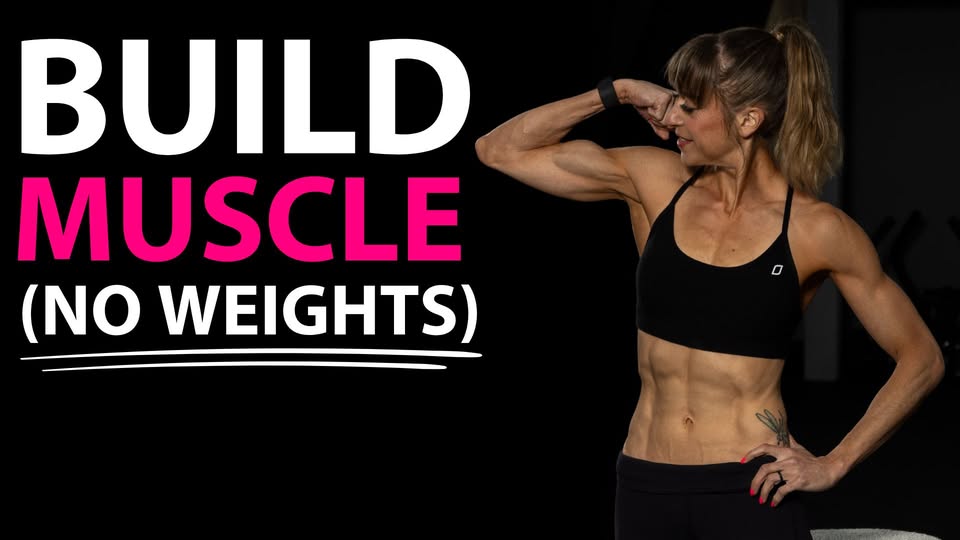Want to build muscle?
Create progression in your workouts.
Note, I didn’t say “add weight.”
Because while weights are an amazing, and EASY, way to create progression in your training to optimize muscle growth, you can still build muscle without having access to them.
If it challenges you, it will change you.
So you’re not doomed if you’re training from home or with limited equipment.
But you do have to get created and design your workouts with purpose and strategy.
That’s why I want to share 10 tips to adjust those training variables to help you see muscle gains even when weights aren’t an option.

You won’t use all of these in every workout, but there is opportunity in the options.
Tip #1: Vary exercise postures and positions.
If a move is starting to feel too easy, you can make slight adjustments to that movement pattern to create progression and even target different muscle groups to different extents.
Take the basic push up.
You can place your feet up on a couch to make them more challenging and even target your upper pecs more.
You can lift one foot to make them more core intensive.
You can bring your hands closer in to a narrow grip to challenge your triceps even more.
You can do a pike push up over a standard to create a killer shoulder and arm variation.
All of these changes in your exact positioning and posture with the basic push up can help you progress the move and challenge your chest, shoulders and triceps in new ways.
Another way to change your posture is Tip #2: Make moves unilateral.
A unilateral move is a move done on one side or a single arm or leg exercise.
Think single leg squat or airborne lunge. Or even the tricep push up.
When you are only able to use one arm or leg, you’re basically adding weight without having any weights as that one limb is now carrying your entire bodyweight!
Unilateral moves also create more instability which can make moves harder as well.
And even if you can’t yet do a fully unilateral move, you can progress an exercise through an 80/20 variation.
You can do a stagger stance squat to build up to that single leg squat.
Or you can do an 80/20 glute bridge instead of the full single leg glute bridge.
All of these start to shift the weight to one side and not only make moves harder but also help you correct imbalances.
Tip #3: Change the range of motion of an exercise.
Increasing the range of motion of an exercise makes it more challenging while also improving your mobility.
An example of this is going from the basic split squat to the balance lunge.
By placing your back foot up on something, you create more instability but also a bigger range of motion you have to work through, challenging your legs more.
But you can also shrink the range of motion to keep muscles under constant tension.
Instead of that split squat becoming a balance lunge, you could do split squat pulses.
You’ll keep those legs muscles under constant tension without a break to challenge them.
Both can be used to your advantage and you may even find use both variations in a workout even back to back!
Which leads me to tip #4: Don’t be afraid to work the same muscle with multiple exercises in a row.
When you combine multiple moves for the same muscle back to back, you can help yourself work a muscle closer to fatigue and recruit more muscle fibers to drive that amazing muscle growth.
This is different than just doing more reps of the same move because you can use different types of exercises or even different training variables to target the muscle group in different ways and even isolate it.
It’s why I mentioned using multiple ranges of motion back to back. You may do split squats then pulses or even pulses then the full balance lunge.
That uses the change in range of motion to even further isolate a muscle group and work it to fatigue.
But you can also work an area back to back with completely different moves.
You may do a balance lunge and combine it with a single leg squat or front lunge to further target those quads.
But you also don’t have to do another compound move. You could use an isolation exercise.
Tip #5: Don’t forget about isolation moves.
Working a muscle with back to back moves, and honing in on a specific muscle with a more isolated movement, can be a great way to really push to failure and see those amazing muscle gains.
This can be especially key with a stubborn muscle group you want to grow.
Instead of a squat with that balance lunge, you could do the balance lunge and a lean back.
But you can use those isolation exercises to target a muscle that may not be fully fatigued during a compound exercise.
And you can vary when you include the isolation move doing it BEFORE the compound exercise for a bit of pre-fatigue to go into the move tired so you max out with fewer reps or an easier variation.
Or you could do it after as post-exhaust technique, to work it when already tired from the compound move.
Both can be beneficial and used based on how challenging you find the compound move you’re including!
And all of these moves you’re using, both the isolation and compound exercise can be done at different tempos, even using holds!
Tip #6: Change exercise tempo.
Not only can you speed a move up or slow it down, but you can do both through different portions of the movement and even include holds.
You could do a push up, lowering down slowly. Hold at the bottom for a count. Then push back up quickly.
Or you can choose to just emphasize one tempo or one portion of a move.
You can even include the same move done at different tempos back to back to combine it with tip #4 and work a muscle group with back to back moves.
For instance to work your legs with squats, you could start with a wall sit, then do slow 5 count eccentric squats after.
You could even throw in tip #3 and follow the slow eccentric squats with pulse squats.
But realize that the pace at which you do moves can have an impact and we don’t want to just rush through!
One of my favorite ways to perform the wall sit series I just mentioned too actually implements Tip #7: Used timed sets to increase training density.
This tip also helps you implement tip #8, use volume to your advantage
You will find when you’re training with more bodyweight based movements, more reps and sets are needed to challenge you even as you implement these other training techniques.
Own this and focus on increasing your volume, the reps and sets you do, in your training. This doesn’t mean you want to keep just adding more, but it does mean to not fear higher rep ranges.
And it’s a great reason to even use some time sets and circuits.
This can help you pack in more work but without just adding more time to your workouts.
You will also find you push past failure with moves when focusing on working for a set amount of time over just completing within a rep range listed.
With timed circuits and sets, you want to even pick a variation of a move you have to PAUSE during the interval of work to complete.
And you can increase training density for an area by doing intervals of work back to back that work the same muscle group.
This is where you could do that wall sit series I mentioned with the eccentric squats and pulses for intervals of work back to back.
Density interval workout designs like that with back to back intervals of work for the same muscle group can really help you work a muscle to fatigue and force you to do more reps than you would have if you just had a rep range to hit.
Part of working a muscle group with more volume over the week isn’t just about doing more in a single session either. It’s also about working a muscle more frequently over the week.
Tip #9: Increase weekly training frequency.
With more bodyweight based training, you can increase the volume of work you do for a muscle by doing more frequent training sessions.
Work a muscle group 3-4 times a week even to create that challenge.
Without weights, you may find your recovery time between sessions doesn’t need to be as long allowing you to get in more volume with more frequent sessions for the same area!
This can also help you be very efficient in your workouts and use a great diversity of movement types and training techniques for the same area since you have more sessions to use!
Tip #10: Get creative with equipment!
Too often we write off other tools besides weights to create progressions. But bands, sliders, suspension trainers are all amazing ways to progress moves.
They even work to challenge muscles at different points than weights do.
Like bands can create more resistance when a muscle is strongest because resistance increases as stretched over a move like the bicep curl.
They can even really make you fight to control the eccentric and slow down the tempo of that portion of the lift.
And you can even make use of certain things you have around the house to create instability or add resistance or a new challenge.
Towels for instance can reduce traction and allow you to challenge your inner thighs more with a side lunge or kneeling adduction.
But have some fun thinking of other ways to create a challenge in new way.
All 10 of these training techniques are opportunity and options. You may use all of them over the course of your week in different ways or even just a few. But they can all help you create that challenge to build amazing strength and muscle!
Want amazing workouts you can do anywhere? Check out my Dynamic Strength Program…
–> LEARN MORE



0 Comments